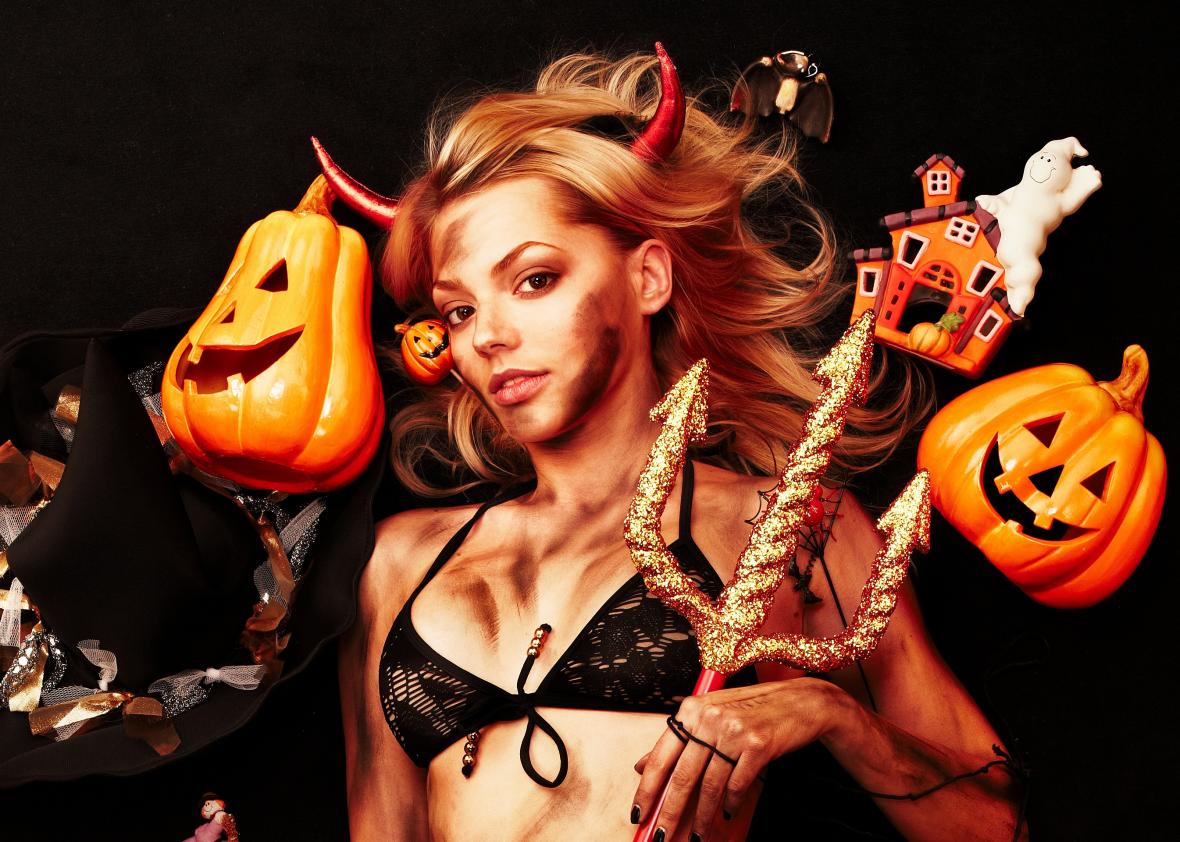Trick-or-Treating After 13 Isn’t Normal!

pshek/Thinkstock
If this were the Prescriptive Blog, I would be writing about the scourge of Halloween costumes for adults and urging Slate’s adult readers to refrain from dressing up this October 31. Were I queen of the world, Halloween would be a holiday for children and children only. Childless adults would no longer be allowed to tarnish their dignity and steal kids’ thunder by donning Superman, cat, and sexy Ken Bone costumes in late October. No one who’s graduated from middle school would ever feel any peer pressure to make or buy a get-up that’s cleverer, creative, intricate, or risqué than everyone else’s get-up. Adults would wear street clothes on Halloween, and all would be right with the world.
Alas, this is not the Prescriptive Blog. It is the Normal Blog. And like it or not—I obviously do not—Halloween costumes for adults have become the norm. Lisa Morton traces Halloween costume creep to the 1970s in her excellent Trick or Treat: A History of Halloween. Morton names a few influences: the Village Halloween Parade, which serves as a kind of autumnal LGBTQ pride celebration in New York City; decidedly non-child-friendly horror films like Halloween giving the holiday a illicit veneer; and Coors’ successful 1980s Halloween campaign starring Elvira, Mistress of the Dark. By the ‘90s, costumes for adults were becoming as common as costumes for kids. I’d have to turn back the clock more than a few decades to be able to argue with a straight face that adults dressing up for Halloween are abnormal.
Here’s what I can argue with a straight face: Older teenagers who go trick-or-treating are abnormal and perhaps even more harmful to the social fabric than adults who dress up. The normal age to retire from trick-or-treating is 13, tops. I know it, you know it, and the sheepish 17-year-old wearing a Trump mask and demanding candy on your front stoop knows it.
Thirteen is a good age to stop trick-or-treating for many reasons. There’s the symbolic unluckiness of 13, which seems appropriate for a holiday devoted to death and doom. There’s the fact that 13 is already a transitional age in many cultures, with rites of passage like bar and bat mitzvah marking the metamorphosis from child to adult. Most importantly, there’s the fact that 13 is the last plausible age at which a kid could sincerely get excited about dressing up and trick-or-treating. After 13, children transform into jaded, surly, rebellious jerks, as predictably as the onset of menses and the deepening of boys’ voices.
Teens who trick-or-treat, you see, aren’t motivated by the same independence-seeking and joyful self-expression that motivate younger trick-or-treaters. Teen trick-or-treaters see trick-or-treating as a sort of scam—a way of sticking it to the man by obtaining the man’s candy without having to pay the man. It is the role of a functional society to teach teens that such scams are antisocial and unsustainable, and also that it’s pretty lame to appropriate a children’s holiday just to get a few free Snickers bars. (You’re in high school? You’re old enough to buy your own damn Snickers bars.) The cynicism that prompts older teens to throw a sheet over their heads and go ransack the neighbors’ Smarties stash casts a pall over the younger children’s pure-hearted excitement about throwing a sheet over their heads and ransacking the neighbors’ Smarties stash. With trick-or-treating, intention is everything—and if we allow teens with malicious intentions to commandeer this holiday, soon there won’t be any treat left in trick-or-treating.
I’m not saying teens can’t celebrate Halloween at all. Now that adults have hijacked Halloween for their own purposes, there’s no reason to deprive teens of the same dubious pleasure. Luckily, there are plenty of ways for older teens to celebrate Halloween without ruining the youngsters’ fun: Wear a costume to school; go to a Halloween dance; host a house party; patronize a local haunted house or hayride. There’s precedent for teens forging their own Halloween traditions: According to Morton, young adults in premodern Britain celebrated Halloween with fortune-telling games aimed at figuring out who their future spouse would be. Teens of yore would get together to pluck cabbages from fields, throw nuts into bonfires, and eat apples in front of mirrors to try to figure out who they would end up marrying. I’m not so naïve that I think that today’s teens would be entertained by the exact same games—but don’t going to slumber parties, gossiping with your friends, and sending flirtatious pics to your crush on Snapchat serve more or less the same purpose?
If you’re a teen, or a parent of a teen, and you wish that trick-or-treating could continue past the age of 13, I offer you a cautionary tale. In 1964, a 47-year-old Greenlawn, New York, resident named Helen Pfeil handed out dog biscuits, steel wool pads, and ant poison to teenaged trick-or-treaters on Halloween. “Aren’t you a little old to be trick-or-treating?” she reportedly asked them as she handed out these suspect treats. Now, I would never suggest that people who trick-or-treat past the age of 13 deserve to be poisoned… But why take the risk?
Read more from Normal, Slate's pop-up blog about how you're supposed to do it.

